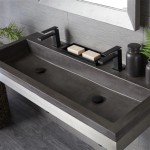Bathroom Sink Standard Size In Cm
Determining the standard size of a bathroom sink in centimeters requires understanding that “standard” can be a relative term. While there are common dimensions, the ideal size depends on various factors, including the bathroom’s overall size, the sink’s intended use, and the aesthetic preferences of the homeowner or designer. This article will delve into the typical dimensions of different types of bathroom sinks, providing a comprehensive overview in metric units.
The bathroom sink, also known as a washbasin, is a crucial fixture in any bathroom. It is used for handwashing, face washing, and other personal hygiene tasks. Selecting the appropriate size ensures comfortable usage and efficient space utilization. Ignoring size considerations can lead to an inconvenient and aesthetically displeasing bathroom design.
Generally, bathroom sink sizes are classified based on their installation type. These types include, but are not limited to, vanity sinks, pedestal sinks, wall-mounted sinks, and vessel sinks. Each type has its own average size range, which we will explore in detail.
Vanity Sink Dimensions
Vanity sinks, also known as cabinet sinks, are integrated into a bathroom vanity unit, which provides storage space underneath the sink basin. These are among the most common types of bathroom sinks due to their practicality and storage capacity. The dimensions of a vanity sink are determined by the size of the vanity cabinet itself.
The width of a standard vanity sink typically ranges from 45 cm to 75 cm. Smaller vanities, often found in powder rooms or compact bathrooms, may have sinks as narrow as 30 cm. Larger vanities in master bathrooms can accommodate double sinks or larger single sinks, extending the width to 90 cm or even 120 cm or more. These larger sizes typically accommodate two separate sinks.
The depth (front to back) of a vanity sink usually falls between 40 cm and 55 cm. This depth allows for comfortable reach and minimizes splashing while washing. Deeper sinks are available, but they may require more space and could potentially make the vanity unit feel cramped.
The height of the vanity unit, including the sink, is generally standardized to be between 80 cm and 90 cm. This height is considered comfortable for most adults. However, taller individuals might prefer a higher vanity, which can be achieved by customizing the vanity cabinet or adding a platform beneath the sink.
The bowl depth within the vanity sink itself can vary. A shallower bowl depth of around 10 cm to 15 cm is common for smaller sinks or sinks intended for light use. Deeper bowls, measuring 15 cm to 20 cm, are better suited for more frequent use and minimizing splashing.
When choosing a vanity sink, it's crucial to consider the overall dimensions of the bathroom and the available space. A vanity that is too large can overwhelm a small bathroom, while a vanity that is too small might not provide adequate storage or sink space.
Pedestal Sink Dimensions
Pedestal sinks are freestanding sinks that consist of a basin supported by a pedestal base. They are a classic and elegant choice, particularly suitable for smaller bathrooms where space is limited. Unlike vanity sinks, pedestal sinks do not offer built-in storage.
The width of a typical pedestal sink ranges from 45 cm to 60 cm. Their narrower profile makes them ideal for tight spaces where a larger vanity would be impractical. Some smaller models might even be slightly less than 45 cm in width.
The depth of a pedestal sink generally falls between 40 cm and 50 cm. This depth provides sufficient space for washing without requiring excessive floor space. As with vanity sinks, deeper basins can be found but are less common.
The overall height of a pedestal sink is typically between 80 cm and 90 cm, similar to vanity sinks. This height ensures comfortable use for most adults. Since the height is fixed by the pedestal, adjustments are less feasible compared to vanity sinks.
The basin depth of a pedestal sink can vary, but it usually ranges from 12 cm to 18 cm. This depth provides a balance between functionality and aesthetics, allowing for comfortable washing without appearing too bulky.
When selecting a pedestal sink, it’s important to consider the plumbing connections. Pedestal sinks conceal the drainpipe and water supply lines to some extent, but they still require proper alignment with the existing plumbing. Careful planning is essential to ensure a clean and functional installation.
Wall-Mounted Sink Dimensions
Wall-mounted sinks, also known as floating sinks, are attached directly to the wall without a supporting cabinet or pedestal. They offer a modern and minimalist aesthetic and are particularly suitable for small bathrooms, as they free up floor space.
The width of a wall-mounted sink typically ranges from 40 cm to 60 cm. The exact width depends on the design and style of the sink. Narrower sinks are common in compact bathrooms or powder rooms.
The depth of a wall-mounted sink is usually between 35 cm and 50 cm. This depth ensures sufficient space for washing while minimizing the sink's projection into the room. Shallower sinks are available for very tight spaces.
The height of a wall-mounted sink is adjustable, allowing for customization to suit the user's needs. The standard mounting height is between 80 cm and 90 cm, but this can be adjusted based on individual preferences or accessibility requirements. It's crucial to ensure the wall can adequately support the sink's weight, especially when mounted at a non-standard height.
The basin depth of a wall-mounted sink can vary, but it generally ranges from 10 cm to 18 cm. The depth should be sufficient to contain water and prevent splashing, while also maintaining a sleek and minimalist appearance.
Installation of a wall-mounted sink requires careful planning and attention to detail. The wall must be structurally sound and capable of supporting the weight of the sink and any water it contains. Proper plumbing connections are also essential to ensure a leak-free and functional installation.
Vessel Sink Dimensions
Vessel sinks, also known as above-counter sinks, sit on top of the bathroom countertop rather than being recessed into it. They are a stylish and contemporary choice that can add a unique focal point to the bathroom. Vessel sinks come in a wide range of shapes, sizes, and materials.
The width of a vessel sink typically ranges from 30 cm to 50 cm. The exact width depends on the shape and design of the sink. Round and oval vessel sinks tend to be smaller, while rectangular or square vessel sinks can be wider.
The depth of a vessel sink is generally between 30 cm and 50 cm, similar to the width. The depth should be proportional to the width to maintain a balanced and aesthetically pleasing appearance.
The height of a vessel sink is a crucial consideration, as it affects the overall height of the countertop and sink. The height of the sink itself typically ranges from 10 cm to 20 cm. The countertop height should be adjusted accordingly to ensure a comfortable overall height of between 80 cm and 90 cm. For example, if the vessel sink is 15 cm tall, the countertop should be around 65 cm to 75 cm high.
The basin depth within the vessel sink can vary, but it is generally deeper than other types of sinks, ranging from 15 cm to 25 cm. This depth helps to contain water and prevent splashing, especially since the sink sits above the countertop.
When selecting a vessel sink, it’s essential to consider the countertop material and faucet style. The countertop should be durable and water-resistant, and the faucet should be tall enough to reach over the rim of the sink. Proper drainage is also crucial, so ensure the drainpipe is correctly aligned and installed.
In summary, determining the "standard" size of a bathroom sink in centimeters involves understanding the different types of sinks and their typical dimensional ranges. Vanity sinks typically range from 45 cm to 75 cm in width and 40 cm to 55 cm in depth. Pedestal sinks are generally narrower, ranging from 45 cm to 60 cm in width and 40 cm to 50 cm in depth. Wall-mounted sinks are similar in size, typically ranging from 40 cm to 60 cm in width and 35 cm to 50 cm in depth. Vessel sinks can vary widely in size, but they generally range from 30 cm to 50 cm in both width and depth, with a height ranging from 10 cm to 20 cm.
Ultimately, the ideal bathroom sink size depends on the specific needs and preferences of the user, as well as the overall design and layout of the bathroom. Careful consideration of these factors will ensure a functional and aesthetically pleasing bathroom space.

Standard Bathroom Sink Dimensions With Photos Upgradedhome Com

Standard Bathroom Sink Dimensions With Photos Upgradedhome Com

Standard Bathroom Sink Dimensions With Photos Upgradedhome Com

Standard Bathroom Sink Dimensions With Photos Upgradedhome Com

51 Cm 20 Inch White Rectangle Shape Grade A Vitreous China Vessel Bathroom Sink Medium Size Counter Top Ceramic Washbasin With Round Corner Made In Com

Top 45 Useful Standard Dimensions Engineering Discoveries Bathroom Interior Design Plan Guide

Bathroom And Restroom Measurements Standards Guide

What S The Standard Depth Of A Bathroom Vanity

Bathroom Sink Dimensions And Guidelines With 3 Drawings Homenish In 2024 Sizes

Ruvati 16 In X 11 Undermount Bathroom Sink Brushed Stainless Steel Rvh6107 The Home Depot







